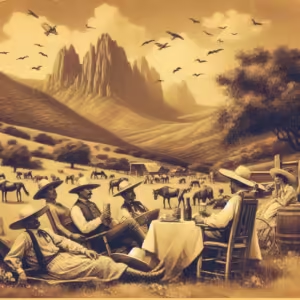In the sweltering heat of the American Southwest, a tradition deeply rooted in practicality and cultural heritage continues to thrive: the siesta. This time-honored practice, derived from the Latin word “sexta” (the sixth hour), designates a midday rest or nap that has been embraced by communities living in hot climates for centuries.
Historical Roots of the Southwest Siesta
The siesta is believed to have originated in Spain, where it became a necessary respite from the oppressive midday heat. As Spanish explorers and settlers made their way to the New World, they brought with them not only their language and customs but also their midday rest tradition.

In the arid regions of the Southwestern United States, the siesta found a natural home. The practice provided a way to escape the hottest part of the day, ensuring that people could recharge and remain productive later in the afternoon and evening.
Cultural Significance of the Southwest Siesta
In Southwestern towns and villages, the siesta is more than just a nap; it is a cultural institution. Businesses and shops often close their doors in the early afternoon, allowing employees and owners to retreat to the cool interiors of their homes. Streets that were bustling with activity just hours before fall into a serene stillness, only to come back to life as the sun’s intensity begins to wane. 🌞

The siesta also serves as a time for families to come together. Shared meals, conversations, and moments of rest strengthen familial bonds, reflecting the close-knit nature of many Southwestern communities. This midday break provides an opportunity to slow down and appreciate the simple pleasures of life, an increasingly rare luxury in today’s fast-paced world. 🏡💤
Health Benefits of the Southwest Siesta
Modern science has begun to uncover the benefits of this ancient practice. Studies have shown that short naps can improve mood, enhance alertness, and boost cognitive performance. In the extreme heat of the Southwest, a siesta helps to avoid heat exhaustion and other heat-related illnesses, making it a practical health measure as well as a cultural one. 🧠💪
The Southwest Siesta in Modern Times
While the siesta remains a cherished tradition in many rural and smaller communities, urbanization and modern work schedules have challenged its practice. In larger cities, the demands of contemporary life often clash with the leisurely pace of a siesta. However, there is a growing recognition of the need to incorporate restful breaks into our daily routines, leading some workplaces to create nap-friendly environments or flexible work hours that respect the spirit of the siesta.

The influence of the siesta can also be seen in the rising popularity of “power naps” in corporate culture, where short, strategic naps are encouraged to improve productivity and employee well-being. 🏙️😴
Embracing the Southwest Siesta Today
The siesta is a testament to the wisdom of adapting to one’s environment and finding balance between work and rest. In the Southwest, this midday nap is more than a habit—it’s a symbol of a lifestyle that values health, family, and the natural rhythms of the day. As we continue to navigate the challenges of modern living, the siesta offers a timeless reminder of the importance of taking a moment to pause, rest, and rejuvenate. 🌵✨
